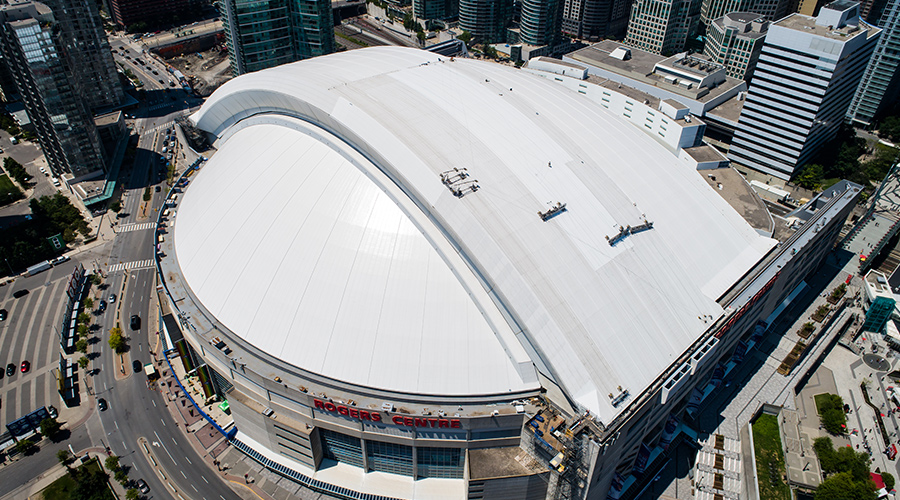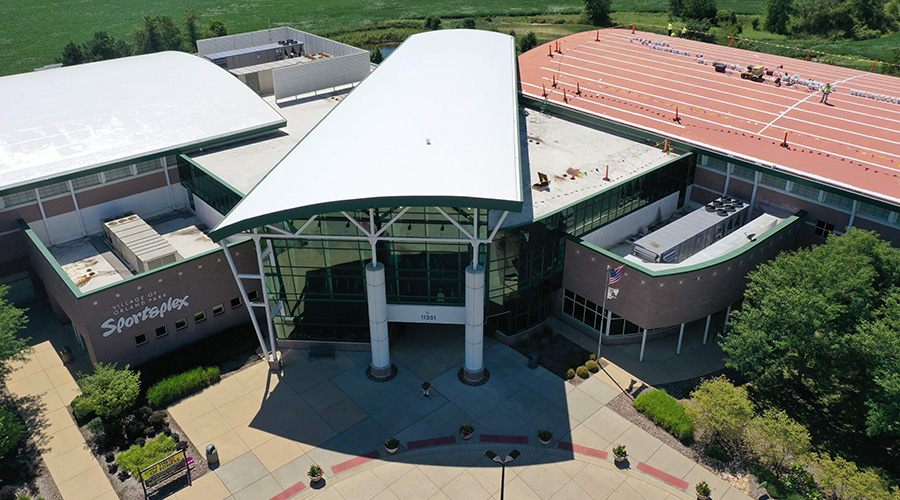ROOFING: A Prescription for Savings
Managers in health care facilities discuss maintenance and inspection strategies that benefit the bottom line
Roof leaks in any facility can disrupt operations. But hospitals are filled with unique work areas, such as surgical suites, so a roof leak can have devastating consequences, from structural damage to destruction of expensive clinical equipment.
Worse still, institutional organizations defer envelope maintenance for purely budgetary reasons. Many maintenance managers cite a familiar, time-worn adage about maintenance operations in institutional settings never earning any money — only spending it. This trend is the culprit, they say.
Regardless of the reason, says Mike Van Wormer, director of facilities for the Finger Lakes Health in New York, building-improvement incentives simply are not available like they were 15 or 20 years ago.
“I can get incentives for lamp retrofits or cogen applications,” he says. “But envelope incentives? No way. Let’s face it, building envelopes just aren’t that sexy.”
Even if envelope repairs are decidedly unsexy, regular and comprehensive roof maintenance is incredibly important, as one hospital maintenance manager recently learned. When a leak developed last year in the roof above the intensive care unit of his hospital and started dripping on a patient, he and his staff had to scramble to locate and stop the leak.
However horrifying, this anecdote illustrates the vital role roofing maintenance plays in health care facilities. Responsive, proactive maintenance and frequent inspections are two ways to maximize roof performance and longevity. But managers also should be prepared to undertake the more difficult task of convincing administrators to set aside a portion of the operation’s budget for capital improvements, including roofing projects.
Roofing Challenges
What’s unique about hospitals is the amount of equipment up their roofs, Van Wormer says. But even when membrane fields are intact, riser curbs and platforms require flashing, which can create a likely spot for water entry.
Hospitals also differ from municipal or government-funded buildings in the ways they use their maintenance money, Van Wormer adds.
“Those facilities – schools in particular – can be notorious for ignoring physical facilities,” he says. “Schools don’t have to be as diligent, because in 20 years, when the current roof needs replacing, they can set it to bond.” That’s why hospitals need to be diligent about routine preventative maintenance — to help conserve roofing longevity.
Rich Hertlein, manager of engineering and operations for Cincinnati’s Bethesda North Hospital, agrees. He says membrane roofs can shrink, and that curbs and other roof penetrations can lead to leaks around the flashing. As with Van Wormer’s operation, Hertlein also has significant amounts of rooftop equipment located in mechanical penthouses.
In addition to rooftop equipment, Hertlein says that his hospital’s tendency to add onto existing structures can lead to leaks.
“There hasn’t been a five-year period in the history of the hospital when we haven’t added on,” he says. “Part of the problem of adding on is that we have to tie the new roof into the existing wall system. The flashing on that part of the roofing usually seems problematic.”
Dick Mariani, plant operations supervisor at Kenmore (N.Y.) Mercy Hospital, has greater problems with membrane punctures.
“I’ve got a ballasted roof on an abutting building that’s higher than the adjacent membrane roof,” he says. “In strong winds, sometimes the rocks blow down onto the membrane and then you’ve got a leak.”
Located outside Buffalo, New York, Mariani’s operation is subject to both high winds and heavy snow loads. Mariani says that the weight of the snow load also can cause debris to puncture the membrane.
Solutions
Because patient care is the foremost priority for health care organizations, roof leaks repairs should be conducted as soon as the leak is discovered.
“Any leak should be treated as an emergency situation,” says Dave McCormick, assistant director of operations at the Massachusetts Institute of Technology (MIT) in Cambridge, and who’s responsible for the campus hospital roof and the roofs of the school’s many research laboratories.
Beyond immediate-response efforts, managers say that preventive maintenance, including inspections, patching punctures and routine applications of waterproof, protective coatings to all roof flashing, is essential for extending roof longevity.
Regular inspections also are invaluable to a roofing maintenance program. Managers might lament the amount of mechanical equipment on their roofs, plus the associated foot traffic of equipment repair personnel. But daily foot traffic sometimes can be put to good use in making quick visual inspections of the roof.
“I’ve got seven air handlers up on my roof, and the guys who go up there to work on those also check for other problems, including roofing issues,” Mariani says.
Hertlein and Van Wormer put staffs who service mechanical equipment to similar use.
In addition to these informal daily inspections, managers themselves also should perform scheduled inspections at least once annually. Savvy managers should invite a roofing consultant or vendor – someone who knows the roof and can answer a manager’s questions, and offer suggestions and observations.
“We’re lucky to have a vendor that does some of that work for us gratis," Hertlein says. “He identifies issues and helps us solve them, even though we may not be looking at a roof that [his company] manufactured. Vendors do a good job educating me, and the key is to find someone you trust.”
Hertlein’s sentiment is common among institutional maintenance managers. Van Wormer says that the Finger Lakes Health System also schedules twice-annual inspections conducted by a maintenance supervisor and local contractor.
“We like to use vendors or contractors who are local and who we trust,” Van Wormer says. Local vendors know an organization’s needs and are familiar with regional weather patterns – important considerations to help maximize roofing performance.
Budget Issues
Convincing hospital administrators that an ample budget for roofing maintenance is necessary can be a hard sell, and it is harder still in today’s faltering economy.
Van Wormer says that many maintenance managers face a dilemma when it comes to receiving funding for physical building improvements.
“Resolution is not easily taken from a maintenance standpoint,” he says. “We don’t make money for the organization – we only spend it. Ultimately, if physical buildings aren’t taken care of because of heavy debt loads or because of deferred maintenance, the organization is going to have problems when building systems begin to fail.”
“In a hospital setting, it’s not like I’m a beer can manufacturer, and when I’ve got 92 cans coming from a line that’s supposed to spit out 100, it’s cutting into my profits,” Mariani says. “Maintenance just doesn’t work like that at a hospital. We’re not central to the hospital’s ability to make money; we only spend it.
“Patient-care priorities in a hospital must come first, even if at the expense of other items. It’s a juggling act where patient care must not be dropped.”
To help ensure maintenance departments receive adequate funds for roofing maintenance, managers have adopted some budgeting strategies.
Van Wormer says he schedules one of his twice-annual roofing inspections shortly before capital budget requests are due. In doing so, Van Wormer says he can note roof conditions and know if he needs to attach additional capital budget requests for his facilities’ roofs He also says managers should not defer maintenance when possible. Operations that conscientiously maintain their facilities will be in good shape during economic slumps and can defer some maintenance for a year or two until the economy picks up again.
“As debt-load increases, it becomes harder to maintain interest on debt,” he says. “Because most hospitals operate on a non-profit basis, they’re confined to annual revenue. Hospitals are bound by current fiscal status. Short-term losses are okay, of course, as long as other sectors build non-operating revenues. That’s why it’s so important for maintenance departments to cut costs as much as possible.”
McCormick says it is essential to establish a fund every year for major repair projects, including roofing.
“The key to the program [at MIT] is that we get defined money for roof replacements,” McCormick says. “Not all of the money goes just to roofs; it’s a fund for major repair projects, and some of that money goes towards roof replacement. It’s when you stop the money in that program that you develop problems.”
He added that whenever MIT performs a renovation, the facilities department folds recovering or reroofing into the capital improvement costs of the renovation.
Ultimately, the surest way managers can maximize roofing system performance is through relatively inexpensive regular preventive maintenance.
Hertlein says that because of routine roofing maintenance at his organization, 15-year-old membrane roofs with a 10-year guarantee still have intact membrane fields. Hertlein’s case is proof positive that managers who conduct regular preventive maintenance and respond immediately to roof damage can extend roof longevity and potentially postpone reroofing requests from capital budget.
“It’s the hidden costs that are expensive,” McCormick says. “Fixing the problem is cheap. But potential structural damage is expensive, or when you’ve got leaks into laboratories or on specialized equipment. That’s why roofing leaks can be so expensive."
“Maintenance has to be incorporated into organizational strategy,” Van Wormer says. [Administrators] “have to know that physical building maintenance is vital to their success and account for it in their budgeting strategy.”
Related Topics:











